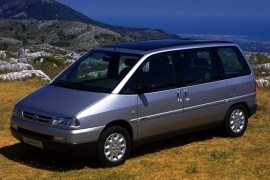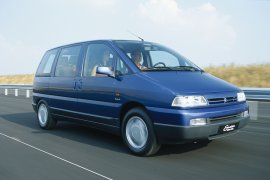CITROEN Evasion Models/Series Timeline, Specifications & Photos
First production year: 1994
Engines: Gasoline, Diesel
Body style: Van
In the mid-'90s, PSA and Fiat joined their forces to build an MPV to counter the VW-Ford and the Renault Espace. The Citroen product was the Evasion.
In 1998, after four years on the market, all of the vehicles built by the so-called Eurovans were restyled, including the Citroen Evasion. Each manufacturer had a certain freedom of incorporating some brand-specific features and some specific engines.
On the outside, the Citroen Evasion featured a different front fascia. Its headlights and grille design were closer to the brand's image, with straight lines and corners that amplified the width of the car. A panoramic sunroof was offered as an option.
Inside, the Evasion was a champion in its class in terms of versatility. Citroen moved the gearshift lever from the floor to the dashboard and the handbrake on the left-side of the driver. As a consequence, there was a passage between the front seats toward the back of the car. The middle and the rear seats could have been moved or completely removed and used as picnic seats and placed on the ground. Last, but not least, the front seats could have been swiveled 180 degrees and the Evasion become a meeting room.
For the engines, the Evasion was available with the PSA engines exclusively. An automatic transmission was offered as an option for the 2.0-liter 16v gasoline engine.
As part of the Eurovan alliance, Citroen built its version of a minivan named Evasion and tried to look different from its siblings.
Even though most European drivers were not very attracted by minivans, their practicality drew some of them. Renault was already on that segment with the Espace since 1984, and the French carmaker was doing well. Its fellow countryman rivals waited for a decade before introducing an adequate competitor, but they did it well right from the start. Citroen-Peugeot built their minivans with some help from Fiat, who produced its Lancia Zeta-Fiat Ulysse lineup.
The Evasion offered a less aggressive styling with its squared-looking headlights but less sharp inner side than its sibling, the Peugeot 806. The front bumper sported a black, unpainted lower area to cut the repair costs from minor scratches. A set of black moldings protected the vehicle from shopping carts and other small chips in the paint on the sides. Unlike the Espace, the Evasion featured rear sliding doors, making the ingress and egress easier for the second and third-row passengers. At the back, a broad and tall liftgate opened the way to the trunk.
Inside, the carmaker installed seven individual seats. Apart from the front ones, all the others could have been removed. That led to a huge storage area of up to 3,300 liters (116.5 cu-ft) from the small 340 liters (12 cu-ft) with all seats in place. Due to the elevated seating position, the carmaker installed the gear stick on the center stack. A dual sunroof was on the options list.
Under the hood, PSA (Peugeot-Citroen) installed the engines for all four Eurovan members. There were only inline-four powerplants, either gasoline or turbo-diesel.

